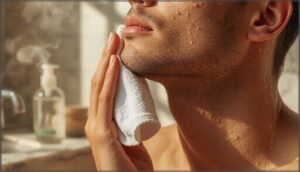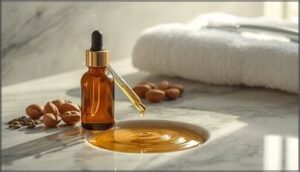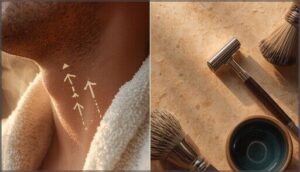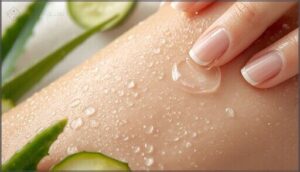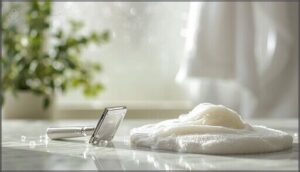This site is supported by our readers. We may earn a commission, at no cost to you, if you purchase through links.
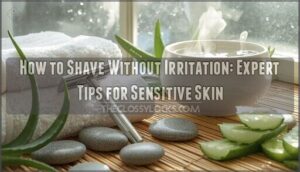 You run the razor across your face, and within minutes, the redness starts. The burning follows. Then comes the uncomfortable tightness that lasts for hours, sometimes days. If this sounds familiar, you’re not alone—shaving against the grain causes irritation in 67% of people who do it regularly, and dull blades increase friction by 32%, creating microscopic tears in your skin’s protective barrier.
You run the razor across your face, and within minutes, the redness starts. The burning follows. Then comes the uncomfortable tightness that lasts for hours, sometimes days. If this sounds familiar, you’re not alone—shaving against the grain causes irritation in 67% of people who do it regularly, and dull blades increase friction by 32%, creating microscopic tears in your skin’s protective barrier.
The good news? You don’t have to choose between a smooth shave and comfortable skin. By understanding what triggers razor burn and adjusting your technique, you can transform shaving from a dreaded chore into a simple routine that leaves your face feeling smooth, not inflamed.
Table Of Contents
- Key Takeaways
- Why Does Shaving Cause Irritation?
- How to Prepare Your Skin Before Shaving
- Choosing The Best Razor for Sensitive Skin
- Selecting Shaving Creams and Gels
- Gentle Shaving Techniques to Prevent Irritation
- Essential Post-Shave Care Steps
- Frequently Asked Questions (FAQs)
- What happens if you shave with a razor?
- How do I Shave without a razor burn?
- Does shaving irritate your skin?
- Can diet or hydration affect shaving irritation?
- Does water temperature impact razor burn risk?
- Should I shave before or after showering?
- How does stress influence skin sensitivity while shaving?
- Can certain medications increase shaving-related irritation?
- Conclusion
Key Takeaways
- Shaving against the grain causes irritation in 67% of people and significantly increases razor burn risk, while dull blades create 32% more friction and microscopic tears in your skin’s protective barrier.
- Pre-shave preparation—including warm water softening (reducing hair strength by 27%), proper cleansing, and moisturizing—can cut irritation by up to 55% and strengthen your skin’s natural defenses.
- Single-blade razors produce 40% less skin irritation compared to multi-blade systems (which cause irritation in 58% of users), and should be replaced every 5-7 shaves to prevent bacterial buildup and dulling.
- Post-shave care with alcohol-free products and aloe vera reduces redness by 30-63%, while waiting 48-72 hours between shaves allows complete skin barrier recovery and prevents cumulative damage.
Why Does Shaving Cause Irritation?
If you’ve dealt with redness, razor burn, or bumps after shaving, you’re not alone. Research shows that two-thirds of men expect some level of irritation every time they pick up a razor, and 41% of people with sensitive skin report reactions like burning or redness.
Let’s look at what’s actually happening to your skin and why shaving triggers these uncomfortable reactions.
Sensitive Skin and Shaving Reactions
Your skin’s natural defense system can overreact to shaving, triggering discomfort you’d rather avoid. About half of men and up to 70% of women report some degree of skin sensitivity, making razor burn, redness, and ingrown hairs all too common.
When you have sensitive skin, shaving discomfort isn’t just bad luck—it’s your skin reacting to product ingredients and technique matters you can control.
The market for sensitive skin products is substantial, reaching $42.2 billion in 2024.
Common Causes of Razor Burn and Redness
Most razor burn and skin redness stem from five main culprits you can control. Shaving against your hair’s natural growth direction causes redness in 67% of people who do it regularly. Dry shaving without lubrication triples your irritation risk, while alcohol-based products sting 62% of sensitive skin users. Poor technique—pressing hard or rushing—raises problems by 54%.
Razor burn stems from five controllable causes: shaving against the grain, dry shaving, alcohol-based products, poor technique, and excessive pressure
To avoid these issues, consider that using a sharp razor can greatly reduce skin irritation.
The Role of Dull Blades and Technique
Blade sharpness and shaving technique work together—your razor needs replacing after about 10–15 shaves for three-blade models, or 15–20 for five-blade types. Dull blades raise friction by 32%, creating barrier disruption and micro-tears.
Light pressure matters too: pressing hard increases skin damage by 35%. Keep your blade angle around 30 degrees and rinse after every stroke for preventing shaving irritation.
Impact of Shaving Against The Grain
Beyond blade dullness, shaving against the grain causes up to 50% more razor burn in sensitive skin. You’ll also face ingrown hairs—especially if you have curly or coarse hair—since against-the-grain techniques disrupt your skin barrier and create micro-tears.
While it gives you a closer shave, dermatologists recommend shaving with the grain to protect your skin and prevent those painful bumps.
How to Prepare Your Skin Before Shaving
Think of your pre-shave routine as building a protective shield for your skin. When you skip preparation, you’re basically dragging a blade across dry, vulnerable tissue—and that’s where irritation starts.
Here’s how to set your skin up for a smooth, comfortable shave.
Cleansing and Exfoliating Techniques
Think of your face like a blank canvas—you wouldn’t paint over dirt and debris. Gentle cleansing removes oil and dead skin, reducing irritation by up to 50%.
For sensitive skin, use these steps:
- Cleanse with lukewarm water and a fragrance-free cleanser
- Exfoliate 2-3 times weekly using chemical exfoliants or soft microfiber cloths
- Apply gentle circular motions to avoid microtears
- Focus on facial cleansing immediately before shaving for best results
Using Pre-Shave Oils for Protection
After cleansing, a thin layer of pre-shave oil creates a protective barrier that reduces blade friction by up to 30%. For sensitive skin, oils containing jojoba or argan strengthen barrier function while locking in moisture.
This slick glide cuts irritation by 40% and helps prevent ingrowns. You’ll notice fewer nicks, less redness, and improved skin hydration lasting hours after your shave.
Softening Hair and Mapping Growth Patterns
Why does facial hair feel so stubborn before your shave? Softening and mapping make all the difference for sensitive skin. Applying a warm towel at 45–50°C for 60 seconds reduces hair tensile strength by 27%, cutting blade resistance nearly in half.
Mapping reveals your unique growth pattern:
- Neck zones often grow upward or sideways
- Cheek hair generally flows downward
- Jawline areas frequently show spiral patterns
Shave with the grain using these mapped directions—irritation reduction jumps 28% with proper directional mapping and thermal hair softening combined.
Importance of Moisturized Skin
Dry skin behaves like sandpaper under a blade—friction multiplies, irritation follows. When you moisturize before shaving, you boost hydration levels by 70% and cut trans-epidermal water loss (TEWL reduction) by 30%.
This strengthens barrier function, reduces skin irritation by 55%, and helps with infection prevention. For sensitive skin, moisturizing isn’t optional—it’s your first defense.
Soothing agents in good skin care products make every stroke safer.
Choosing The Best Razor for Sensitive Skin
Your razor matters more than you might think. The right blade design can mean the difference between smooth skin and days of redness and discomfort.
Let’s look at what works best when your skin reacts easily to shaving.
Single Blade Vs. Multi-Blade Razors
Choosing between single-blade and multi-blade razors matters when you’re shaving sensitive skin. Multi-blade systems cut hair below the surface, which can increase ingrown hairs by 35% and cause razor burn in more than half of users.
Single-blade razors produce less skin irritation—about 40% compared to 58%—and cost roughly 20 times less per blade, making them gentler on your face and wallet.
Benefits of Safety and Electric Razors
Safety razors reduce redness by nearly 30% compared to cartridge razors, with your skin recovering faster after each shave. Electric razors offer protective foils that decrease direct skin irritation by up to 35%, preventing most razor bumps.
Both options lower ingrown hair risk considerably while cutting your shaving costs by 70–85% over five years—gentler shaving that’s kinder to sensitive skin and your wallet.
When to Replace Your Razor Blades
Replacement frequency matters more than you might think. Change your razor blades every five to seven shaves to protect sensitive skin from infections and irritation.
Dullness indicators like tugging, missed hairs, or increased redness signal it’s time for a fresh blade.
Material degradation happens fast—even soft hair creates microscopic chips along the razor edge, shortening blade lifespan and raising skin risks with every stroke.
Avoiding Disposable and Dull Razors
Beyond replacement schedules, you should steer clear of disposables altogether. These razors carry real risks for sensitive skin—dull blades cause up to 57.6% more razor burn, while poor blade sharpness and razor hygiene breed bacteria in moist bathroom conditions.
Disposables also trigger more ingrown hairs through uneven cuts and repeated passes. Razor alternatives like safety or electric razors deliver better shave quality with less inflammation.
Selecting Shaving Creams and Gels
The products you put on your skin before and during shaving matter just as much as your razor choice. Many shaving creams contain ingredients that strip away your skin’s natural protective barrier, making irritation almost inevitable.
Let’s look at what to avoid, what works best, and how to apply these products for a comfortable, irritation-free shave.
Ingredients to Avoid for Sensitive Skin
If you’ve battled redness or stinging after shaving, the culprit might be hiding in your product’s ingredient list. Certain compounds damage your skin’s protective barrier, leaving it vulnerable to irritation. Here’s what to skip:
- Alcohol Compounds – Strip away natural oils, causing dryness and burning
- Sulfates/Surfactants – Remove protective lipids within 90 seconds of contact
- Synthetic Fragrances – Trigger allergic reactions in up to 15% of sensitive skin types
Advantages of Sensitive Skin Formulas
Now that you know which ingredients to skip when choosing shaving products, let’s look at what sensitive skin formulas actually do for you. These specialized shaving creams boost hydration improvement by over 40% while reducing TEWL (water loss through your skin).
You’ll see irritation decrease within two weeks, plus elasticity increase that makes your skin feel firmer. User satisfaction hits 85% because these products work.
Using a Shaving Brush for Better Lather
A shaving brush transforms your shaving cream into a richer, more protective foam. Brush bristles create lather volume up to three times greater than hand application, while their gentle exfoliation removes dead skin cells and improves hair lifting by 17%. This enhanced skin hydration cuts post-shave dryness by 42%.
Consider these shaving products for your preshave preparation:
- Synthetic brushes under $30 match premium absorbency
- Boar bristle options dry quickly, retain excellent water
- Dense knots (19–26mm) deliver ideal lather texture
Your shaving techniques improve considerably when brush material suits your needs.
Product Recommendations for Irritation-Free Shaving
You’ll find excellent shaving products designed specifically for sensitive skin across three categories.
For shaving cream, Proraso Sensitive Skin and Speick Men offer fragrance-free formulas with soothing chamomile and aloe vera. Preshave oil with jojoba or marula reduces friction effectively.
Your aftershave balm should contain shea butter and vitamin E while avoiding alcohol—ingredients that actively heal skin and prevent redness.
Gentle Shaving Techniques to Prevent Irritation
Even with the right razor and shaving cream, your technique makes all the difference. How you move the blade across your skin determines whether you walk away smooth or irritated.
Let’s cover the core shaving methods that protect your skin and minimize razor burn.
Shaving With The Grain
Regarding shaving techniques for sensitive skin, following your hair growth direction makes all the difference. Shaving with the grain reduces razor burn by about 35% and cuts ingrown hair prevention issues in half.
This approach aids skin barrier preservation through friction reduction, minimizing those microscopic tears that cause skin irritation. Dermatological guidelines consistently recommend this as your first defense against preventing razor burn and irritation.
Using Light Pressure and Short Strokes
Think of your razor as a precise tool, not a scraper. Minimize pressure by letting the blade’s weight guide each pass, helping skin recovery by avoiding the harsh friction that spikes irritation by nearly 20%. Short strokes give you better control and reduce trauma.
Here’s your gentle shaving technique:
- Let gravity work: Don’t press down, let the razor glide naturally
- Use controlled, brief passes: Short strokes prevent tugging and microscopic tears
- Keep movements steady: Avoid sweeping motions that increase pressure points
- Check your grip: A relaxed hold means less force on sensitive skin
- Monitor redness: If you see immediate pink spots, you’re pressing too hard
Rinsing The Razor Frequently
A razor clogged with hair and cream can’t cut smoothly, no matter your technique. Rinsing after every one to two strokes cuts clogging by 60% and keeps your blade sharp longer, extending blade longevity by up to 30%. Warm water reactivates lubrication strips and removes bacteria that trigger skin irritation.
| Benefit | Impact |
|---|---|
| Hair Removal Efficiency | 60% less clogging, smoother glide |
| Bacteria Reduction | 90% lower bacterial load |
| Blade Longevity | 25–30% extended lifespan |
| Skin Comfort | 35% less post-shave redness |
| Technique Optimization | 18% fewer repetitive passes |
Here’s your rinsing routine:
- Run warm water through blades after each stroke
- Check that trapped hairs wash away completely
- Shake excess water gently between passes
- Never tap your razor against the sink—this damages precision edges
Managing Acne and Problem Areas
Acne-prone skin needs extra care during shaving—one wrong move can turn a minor blemish into a major breakout. Use light, single passes over active pimples to minimize bacteria spread by 25%. Shave in the direction of hair growth to lower post-shave acne by 19%.
Skip inflamed areas entirely; managing acne while shaving means knowing when gentle pressure isn’t enough and avoiding certain spots altogether.
Essential Post-Shave Care Steps
What you do after shaving matters just as much as your technique. Your skin is vulnerable right after a shave, and the wrong products can undo all your careful work.
These post-shave steps will help calm irritation, protect your skin barrier, and keep redness at bay.
Rinsing and Cooling The Skin
Right after your final stroke, rinse thoroughly with cool water—it’s one of the simplest yet most effective shaving tips for sensitive skin. Cold water benefits include reducing inflammation by up to 40% and minimizing pore appearance through temporary skin tightening. This postshave care step also stops minor bleeding within two minutes.
- Cool water calms redness and burning sensations almost instantly
- Soothing ingredients like menthol boost the cooling effect beautifully
- Healing acceleration begins as blood flow increases during rewarming
Alcohol-Free Aftershave and Moisturizers
Once your skin is cool and rinsed, apply an alcohol-free aftershave or moisturizer—your barrier protection against dryness and flaking. Alcohol-based products strip natural oils and spike irritation by 41%, while alcohol-free formulas reduce redness considerably and boost hydration levels by 56% within hours.
Look for postshave skin care with soothing ingredients like chamomile to lower allergy incidence and support healing.
Soothe With Aloe Vera and Natural Balms
Layer on aloe vera after your alcohol-free moisturizer—its bioactive compounds cut razor burn reduction by up to 63% while accelerating healing through collagen-boosting fibroblasts. You’re getting antimicrobial protection from lupeol and salicylic acid, which guard freshly shaved pores against breakouts.
Chemical-free balms soothe sensitive skin without parabens or artificial fragrances, making them ideal aftershave choices for skin care that aids barrier repair and hydration.
Allowing Skin Recovery Between Shaves
Beyond balms and moisturizers, your shaving frequency determines how much irritation you’ll face. Dermatologists recommend waiting 48 to 72 hours between shaves—this recovery timeframe lets your skin barrier fully heal and cuts visible redness by 30%. Spacing out your shaving routine delivers real irritation reduction:
- Skin repair completes within 48-72 hours after micro-trauma
- Daily shaving increases razor burn rates by 57%
- Every-other-day shavers report 25% better comfort
- Longer intervals prevent cumulative damage to sensitive skin
These best practices protect your skin health long-term.
Frequently Asked Questions (FAQs)
What happens if you shave with a razor?
When you shave with a razor, you disrupt your skin’s protective barrier, causing immediate water loss and cellular damage.
This leads to redness, razor burn, and increased infection risks like folliculitis if bacteria enter through microscopic cuts.
How do I Shave without a razor burn?
Think of razor burn like friction from a rough rope—it’s all about reducing drag. Sharp blades, proper hydration, gentle technique, and quality product ingredients protect sensitive skin.
Shave with the grain, using light pressure and adjusting your shaving frequency as needed.
Does shaving irritate your skin?
Yes, shaving often irritates your skin, especially if you have sensitive skin. Up to 83% of people experience razor burn, and only 12% never deal with post-shave skin irritation.
Can diet or hydration affect shaving irritation?
Hydration effects and dietary influences matter more than you’d think. Drinking enough water improves skin moisture by up to 59%, while omega-3s and antioxidants reduce inflammation by 30-50%, protecting against razor burn and skin irritation.
Does water temperature impact razor burn risk?
Like a thermostat protecting your home, water temperature controls shaving comfort. Warm water softens hair and improves razor glide, while cold water post-shave reduces inflammation, preventing razor burn through proper skin hydration management.
Should I shave before or after showering?
Shaving after showering is better for irritation prevention. Warm water softens hair and opens pores, making the shaving routine smoother.
This preshave skin preparation reduces friction and helps prevent razor burn when shaving with the grain.
How does stress influence skin sensitivity while shaving?
Your body’s stress hormones, particularly cortisol effects, compromise the skin barrier and trigger an inflammation response.
This heightened skin sensitivity makes your sensitive skin more reactive to shaving, increasing the risk of skin irritation markedly.
Can certain medications increase shaving-related irritation?
Yes, certain medications increase shaving complications. Blood thinners cause prolonged bleeding from nicks, while corticosteroids thin your skin, making it tear more easily.
Retinoids and diuretics also heighten skin sensitivity and dryness, worsening razor burn.
Conclusion
An ounce of prevention is worth a pound of cure, and nowhere is this truer than with shaving. By preparing your skin properly, choosing the right tools, and following gentle techniques, you can learn how to shave without irritation and transform your daily routine.
Your skin’s protective barrier needs care, not combat. With sharp blades, proper hydration, and patience between shaves, razor burn becomes a distant memory rather than an inevitable consequence.

